Road Infrastructure Analysis with Reference to Traffic Stream Characteristics and Accidents: An Application of Benchmarking Based Safety Analysis and Sustainable Decision-Making
Abstract
1. Introduction
2. Road Accident Risk Index and Benchmarking
3. Materials and Methods
3.1. Framework for Research Design
- Step 1.
- Study area selection and segmentation of motorway (M-2) on per km basis.
- Step 2.
- Selection of accident-prone segments naming them as decision-making units (DMUs).
- Step 3.
- Selection of variables for calculating traffic accident risk index.
- -
- Output variables were separated as number of accidents (NoA) and number of affected people (NoAP)-killed or injured.
- -
- Input variables were separated as volume/capacity, vehicles km travelled and vehicles hrs Travelled.
- Step 4.
- Application of DEA program using Lingo Software with the concept of minimizing accidents and killing/injuries and maximizing traffic exposure (V/C, VKT, VHT) to calculate composite traffic accident risk index.
- Step 5.
- Application of cross efficient methodology to calculate a unique value of the traffic accident risk index for each DMU and severity ranking.
- Step 6.
- Application of GIS mapping to produce a visual understanding of risk-prone locations on motorways.
- Step 7.
- Discussion about top ten risky motorway sections and decision-making.
3.2. Study Area
3.3. Data Description and Preparation
3.4. Accident Risk Analysis Using Data Envelopment Analysis
3.5. Cross Efficiency Calculation for Ranking
4. Results and Discussion
4.1. Risk Analysis and Calulations
4.2. Risky Segment Identification and Impact on Human Safety
4.3. Safety Management Financial Decision Making
4.4. Advantages and Limitations of Using the DEA Method
5. Limitations of the Study
6. Conclusions
Author Contributions
Funding
Acknowledgments
Conflicts of Interest
References
- Stoohs, R.A.; Guilleminault, C.; Itoi, A.; Dement, W.C. Traffic accidents in commercial long-haul truck drivers: the influence of sleep-disordered breathing and obesity. Sleep N. Y. 1994, 17, 619–623. [Google Scholar] [PubMed]
- Af Wåhlberg, A.; Barraclough, P.; Freeman, J. Personality versus traffic accidents; meta-analysis of real and method effects. Transp. Res. Part F Traffic Psychol. Behav. 2017, 44, 90–104. [Google Scholar] [CrossRef]
- Anand, K. A clinical analysis of outcome in management of head injury in patients with highway road accidents. Int. J. Res. Med. Sci. 2017, 4, 2079–2083. [Google Scholar]
- WHO. Global Status Report on Road Safety 2018. WHO: Geneva, Switzerland, 2018. [Google Scholar]
- WHO. Global Status Report on Road Safety 2015. WHO: Geneva, Switzerland, 2015. [Google Scholar]
- Heydari, S.; Hoseinzadeh, A.; Ghaffarpasand, F.; Hedjazi, A.; Zarenezhad, M.; Moafian, G.; Aghabeigi, M.; Foroutan, A.; Sarikhani, Y.; Peymani, P. Epidemiological characteristics of fatal traffic accidents in Fars province, Iran: A community-based survey. Public Health 2013, 127, 704–709. [Google Scholar] [CrossRef] [PubMed]
- Pathak, S.; Jindal, A.; Verma, A.; Mahen, A. An epidemiological study of road traffic accident cases admitted in a tertiary care hospital. Med. J. Armed Forces India 2014, 70, 32–35. [Google Scholar] [CrossRef] [PubMed][Green Version]
- WHO. Pedestrian Safety: A Road Safety Manual for Decision-Makers and Practitioners; World Health Organization: Geneva, Switzerland, 2013. [Google Scholar]
- Pan, R.-H.; Chang, N.-T.; Chu, D.; Hsu, K.-F.; Hsu, Y.-N.; Hsu, J.-C.; Tseng, L.-Y.; Yang, N.-P. Epidemiology of orthopedic fractures and other injuries among inpatients admitted due to traffic accidents: A 10-year nationwide survey in Taiwan. Sci. World J. 2014. [Google Scholar] [CrossRef]
- DeAngelo, G.; Hansen, B. Life and death in the fast lane: Police enforcement and traffic fatalities. Am. Econ. J. Econ. Policy 2014, 6, 231–257. [Google Scholar] [CrossRef]
- Malara, P.; Malara, B.; Drugacz, J. Characteristics of maxillofacial injuries resulting from road traffic accidents—A 5 year review of the case records from Department of Maxillofacial Surgery in Katowice, Poland. Head Face Med. 2006, 2, 27. [Google Scholar] [CrossRef]
- Golob, T.F.; Recker, W.W.; Alvarez, V.M. Tool to evaluate safety effects of changes in freeway traffic flow. J. Transp. Eng. 2004, 130, 222–230. [Google Scholar] [CrossRef]
- Golob, T.F.; Recker, W.; Pavlis, Y. Probabilistic models of freeway safety performance using traffic flow data as predictors. Saf. Sci. 2008, 46, 1306–1333. [Google Scholar] [CrossRef]
- Yasin Çodur, M.; Tortum, A. An Artificial Neural Network Model for Highway Accident Prediction: A Case Study of Erzurum, Turkey. Promet Traffic Transp. 2015, 27, 217–225. [Google Scholar]
- Wang, C.; Quddus, M.A.; Ison, S.G. Impact of traffic congestion on road accidents: A spatial analysis of the M25 motorway in England. Accident Anal. Prev. 2009, 41, 798–808. [Google Scholar] [CrossRef] [PubMed]
- Ogwueleka, F.N.; Misra, S.; Ogwueleka, T.C.; Fernandez-Sanz, L. An artificial neural network model for road accident prediction: A case study of a developing country. Acta Polytech. Hung. 2014, 11, 177–197. [Google Scholar]
- Dadashova, B.; Arenas-Ramírez, B.; Mira-McWilliams, J.; Aparicio-Izquierdo, F. Methodological development for selection of significant predictors explaining fatal road accidents. Accident Anal. Prev. 2016, 90, 82–94. [Google Scholar] [CrossRef] [PubMed]
- Pande, A.; Abdel-Aty, M. Assessment of freeway traffic parameters leading to lane-change related collisions. Accident Anal. Prev. 2006, 38, 936–948. [Google Scholar] [CrossRef] [PubMed]
- Lord, D.; Manar, A.; Vizioli, A. Modeling crash-flow-density and crash-flow-V/C ratio relationships for rural and urban freeway segments. Accident Anal. Prev. 2005, 37, 185–199. [Google Scholar] [CrossRef]
- Imprialou, M.-I.M.; Quddus, M.; Pitfield, D.E.; Lord, D. Re-visiting crash–speed relationships: A new perspective in crash modelling. Accident Anal. Prev. 2016, 86, 173–185. [Google Scholar] [CrossRef] [PubMed]
- Givehchi, S.; Hemmativaghef, E.; Hoveidi, H. Association between safety leading indicators and safety climate levels. J. Saf. Res. 2017, 62, 23–32. [Google Scholar] [CrossRef]
- Kaye, S.-A.; Lewis, I.; Freeman, J. Comparison of self-report and objective measures of driving behavior and road safety: A systematic review. J. Saf. Res. 2018, 65, 141–151. [Google Scholar] [CrossRef]
- Luoma, J.; Sivak, M. Characteristics and availability of fatal road-crash databases in 20 countries worldwide. J. Saf. Res. 2007, 38, 323–327. [Google Scholar] [CrossRef]
- Golob, T.F.; Recker, W.W. A method for relating type of crash to traffic flow characteristics on urban freeways. Transp. Res. Part A Policy Pract. 2004, 38, 53–80. [Google Scholar] [CrossRef]
- Zhou, M.; Sisiopiku, V. Relationship between volume-to-capacity ratios and accident rates. Transp. Res. Record J. Transp. Res. Board 1997, 1581, 47–52. [Google Scholar] [CrossRef]
- Frantzeskakis, J.M.; Iordanis, D.I. Volume-to-capacity ratio and traffic accidents on interurban four-lane highways in Greece. Transp. Res. Record 1987, 1112, 29–38. [Google Scholar]
- Abdel-Aty, M.; Lee, J.; Siddiqui, C.; Choi, K. Geographical unit based analysis in the context of transportation safety planning. Transp. Res. Part A Policy Pract. 2013, 49, 62–75. [Google Scholar] [CrossRef]
- Wang, Y.; Kockelman, K.M. A Poisson-lognormal conditional-autoregressive model for multivariate spatial analysis of pedestrian crash counts across neighborhoods. Accident Anal. Prev. 2013, 60, 71–84. [Google Scholar] [CrossRef] [PubMed]
- Jovanis, P.P.; Chang, H.-L. Modeling the relationship of accidents to miles traveled. Transp. Res. Record 1986, 1068, 42–51. [Google Scholar]
- Martin, J.-L. Relationship between crash rate and hourly traffic flow on interurban motorways. Accident Anal. Prev. 2002, 34, 619–629. [Google Scholar] [CrossRef]
- Yeo, H.; Jang, K.; Skabardonis, A.; Kang, S. Impact of traffic states on freeway crash involvement rates. Accident Anal. Prev. 2013, 50, 713–723. [Google Scholar] [CrossRef] [PubMed]
- Aljanahi, A.; Rhodes, A.; Metcalfe, A.V. Speed, speed limits and road traffic accidents under free flow conditions. Accident Anal. Prev. 1999, 31, 161–168. [Google Scholar] [CrossRef]
- Elvik, R. Effects on accidents of automatic speed enforcement in Norway. Transp. Res. Record J. Transp. Res. Board 1997, 1595, 14–19. [Google Scholar] [CrossRef]
- Elvik, R.; Christensen, P.; Amundsen, A. Speed and Road Accidents. An Evaluation of the Power Model; TØI report: Oslo, Norway, 2004. [Google Scholar]
- Garber, N.; Ehrhart, A. Effect of speed, flow, and geometric characteristics on crash frequency for two-lane highways. Transp. Res. Record J. Transp. Res. Board 2000, 1717, 76–83. [Google Scholar] [CrossRef]
- Kononov, J.; Lyon, C.; Allery, B. Relation of flow, speed, and density of urban freeways to functional form of a safety performance function. Transp. Res. Record J. Transp. Res. Board 2011, 11–19. [Google Scholar] [CrossRef]
- Malyshkina, N.; Mannering, F. Effect of increases in speed limits on severities of injuries in accidents. Transp. Res. Record J. Transp. Res. Board 2008, 2083, 122–127. [Google Scholar] [CrossRef]
- Hamzeie, R.; Savolainen, P.T.; Gates, T.J. Driver speed selection and crash risk: Insights from the naturalistic driving study. J. Saf. Res. 2017, 63, 187–194. [Google Scholar] [CrossRef] [PubMed]
- Golob, T.F.; Recker, W.W. Relationships among urban freeway accidents, traffic flow, weather, and lighting conditions. J. Transp. Eng. 2003, 129, 342–353. [Google Scholar] [CrossRef]
- Karlaftis, M.G.; Golias, I. Effects of road geometry and traffic volumes on rural roadway accident rates. Accident Anal. Prev. 2002, 34, 357–365. [Google Scholar] [CrossRef]
- Milton, J.C.; Mannering, F.L. The Relationship Between Highway Geometrics, Traffic Related Elements, and Motor Vehicle Accidents; Springer: Berlin/Heidelberg, Germany, 1996. [Google Scholar]
- Noland, R.B.; Oh, L. The effect of infrastructure and demographic change on traffic-related fatalities and crashes: A case study of Illinois county-level data. Accident Anal. Prev. 2004, 36, 525–532. [Google Scholar] [CrossRef]
- Fu, R.; Guo, Y.; Yuan, W.; Feng, H.; Ma, Y. The correlation between gradients of descending roads and accident rates. Saf. Sci. 2011, 49, 416–423. [Google Scholar] [CrossRef]
- Wang, B.; Hallmark, S.; Savolainen, P.; Dong, J. Crashes and near-crashes on horizontal curves along rural two-lane highways: Analysis of naturalistic driving data. J. Saf. Res. 2017, 63, 163–169. [Google Scholar] [CrossRef]
- Benz, T.; Gaitanidou, E.; Tapani, A.; Toffolo, S.; Yannis, G.; Spyropoulou, I. Models on the Road. In Infrastructure and Safety in a Collaborative World; Springer: Berlin/Heidelberg, Germany, 2011; pp. 97–124. [Google Scholar]
- Bergel-Hayat, R.; Debbarh, M.; Antoniou, C.; Yannis, G. Explaining the road accident risk: Weather effects. Accident Anal. Prev. 2013, 60, 456–465. [Google Scholar] [CrossRef]
- Commandeur, J.J.; Bijleveld, F.D.; Bergel-Hayat, R.; Antoniou, C.; Yannis, G.; Papadimitriou, E. On statistical inference in time series analysis of the evolution of road safety. Accident Anal. Prev. 2013, 60, 424–434. [Google Scholar] [CrossRef] [PubMed]
- Yannis, G.; Laiou, A.; Folla, K.; Bauer, R.; Machata, K.; Brandstaetter, C. Comparative analysis of road safety parameters in the European motorways. In Proceedings of the 1st European Road Infrastructure Congress, Leeds, UK, 18–20 October 2016. [Google Scholar]
- Yannis, G.; Papadimitriou, E.; Chaziris, A.; Duchamp, G.; Lejeune, P.; Treny, V.; Hemdorff, S.; Haddak, M.; Lenguerrand, E.; Hollo, P. Building the European Road Safety Observatory. SafetyNet. Deliverable 2.3 Risk Exposure Data Common Framework; European Commission, Directorate-General Transport and Energy, Loughborough University: Leicestershire, UK, 2008. [Google Scholar]
- Yannis, G.; Papadimitriou, E.; Dupont, E.; Martensen, H. Estimation of fatality and injury risk by means of in-depth fatal accident investigation data. Traffic Inj. Prev. 2010, 11, 492–502. [Google Scholar] [CrossRef] [PubMed]
- Yannis, G.; Dragomanovitsa, A.; Laioua, A.; La Torreb, F.; Domenichinib, L.; Richterc, T.; Ruhlc, S.; Grahamd, D.; Karathodoroud, N. Development of an online Repository of Accident Prediction Models and Crash Modification Factors. In Proceedings of the 1st European Road Infrastructure Congress, Leeds, UK, 18–20 October 2016. [Google Scholar]
- Yannis, G.; Papadimitriou, E.; Evgenikos, P. Cost-benefit assessment of selected road safety measures in Greece. In Proceedings of the 13th International Conference on Road Safety on Four Continents, Warsaw, Poland, 5–7 October 2005. [Google Scholar]
- Yannis, G.; Evgenikos, P.; Papadimitriou, E. Best practice for cost-effective road safety infrastructure investments. In Proceedings of the Conference of European Directors of Road (CEDR), Paris, France, 2 April 2008. [Google Scholar]
- Papadimitriou, E.; Filtness, A.; Theofilatos, A.; Ziakopoulos, A.; Quigley, C.; Yannis, G. Review and ranking of crash risk factors related to the road infrastructure. Accident Anal. Prev. 2019, 125, 85–97. [Google Scholar] [CrossRef] [PubMed]
- Yannis, G.; Dragomanovits, A.; Laiou, A.; Richter, T.; Ruhl, S.; La Torre, F.; Domenichini, L.; Graham, D.; Karathodorou, N.; Li, H. Use of accident prediction models in road safety management–an international inquiry. Transp. Res. Procedia 2016, 14, 4257–4266. [Google Scholar] [CrossRef]
- Yannis, G.; Papadimitriou, E.; Evgenikos, P.; Dragomanovits, A. Good practices on cost–effective road infrastructure safety investments. Int. J. Inj. Control Saf. Promot. 2016, 23, 373–387. [Google Scholar] [CrossRef] [PubMed]
- Bishai, D.; Hyder, A.A.; Ghaffar, A.; Morrow, R.H.; Kobusingye, O. Rates of public investment for road safety in developing countries: case studies of Uganda and Pakistan. Health Policy Plan. 2003, 18, 232–235. [Google Scholar] [CrossRef] [PubMed]
- WHO. Global Status Report on Road Safety: Time for Action; World Health Organization: Geneva, Switzerland, 2009. [Google Scholar]
- Hyder, A.A.; Ghaffar, A.; Masood, T.I. Motor vehicle crashes in Pakistan: The emerging epidemic. Inj. Prev. 2000, 6, 199–202. [Google Scholar] [CrossRef]
- PBS. Accident Data Statistics. Available online: http://www.pbs.gov.pk/sites/default/files//tables/Data%20on%20Traffic%20Accidents.pdf (accessed on 20 August 2018).
- Yu, H.; Liu, P.; Chen, J.; Wang, H. Comparative analysis of the spatial analysis methods for hotspot identification. Accident Anal. Prev. 2014, 66, 80–88. [Google Scholar] [CrossRef]
- Qu, X.; Meng, Q. A note on hotspot identification for urban expressways. Saf. Sci. 2014, 66, 87–91. [Google Scholar] [CrossRef]
- Borsos, A.; Cafiso, S.; D’Agostino, C.; Miletics, D. Comparison of Italian and Hungarian Black Spot Ranking. Transp. Res. Procedia 2016, 14, 2148–2157. [Google Scholar] [CrossRef]
- Sorate, R.; Kulkarni, R.; Bobade, S.; Patil, M.; Talathi, A.; Sayyad, I.; Apte, S. Identification of accident black spots on national highway 4 (New Katraj tunnel to Chandani chowk). IOSR J. Mech. Civ. Eng. E ISSN 2015, 12, 61–67. [Google Scholar]
- Sohadi, R.U.R.; Baguley, C. The Identification, Prioritising and Analysis of Accident Blackspots In Malaysia; TRL Transport Research Laboratory: Wokingham, UK, 1994. [Google Scholar]
- Washington, S.; Haque, M.; Oh, J.; Lee, D. Identifying Black Spots Using Property Damage Only Equivalency (PDOE) Factors. In Proceedings of the 16th International Conference Road Safety on Four Continents, Beijing, China, 15–17 May 2013. (RS4C 2013). [Google Scholar]
- BHS. Sequential Data Analysis for Black Spot Identification. In Proceedings of the 4th IRTAD Conference, Oral Presentations, Seoul, Korea, 16–17 September 2009; pp. 219–222. [Google Scholar]
- Elvik, R. State-of-the-Art Approaches to Road Accident Black Spot Management and Safety Analysis of Road Networks; Transportøkonomisk institutt: Oslo, Norway, 2007. [Google Scholar]
- Elvik, R. Comparative analysis of techniques for identifying locations of hazardous roads. Transp. Res. Record 2008, 01, 72–75. [Google Scholar] [CrossRef]
- Mustakim, F.; Busu, A. Identifying, prioritizing and treating hazardous location at Federal Route FT023 (Muar-Segamat). In Malaysian Road Conference, 7th; Ministry of Work Malaysia: Kuala Lumpur, Malaysia, 2007. [Google Scholar]
- Hauer, E.; Persaud, B.N. Problem of identifying hazardous locations using accident data. Transp. Res. Record 1984, 975, 36–43. [Google Scholar]
- Vistisen, D.; Thyregod, P.; Laursen, J.G. Models and Methods for Hot Spot Safety Work; Technical University of DenmarkDanmarks Tekniske Universitet, Department of PlanningInstitut for Planlægning: Lyngby, Denmark, 2002. [Google Scholar]
- Ghadi, M.; Török, Á. A comparative analysis of black spot identification methods and road accident segmentation methods. Accident Anal. Prev. 2019, 128, 1–7. [Google Scholar] [CrossRef] [PubMed]
- Debrabant, B.; Halekoh, U.; Bonat, W.H.; Hansen, D.L.; Hjelmborg, J.; Lauritsen, J. Identifying traffic accident black spots with Poisson-Tweedie models. Accident Anal. Prev. 2018, 111, 147–154. [Google Scholar] [CrossRef] [PubMed]
- Wegman, F. Road Accidents: Worldwide A Problem that Can Be Tackled Successfully; Permanent International Association of Road Congresses, Ed.; SWOV: Paris, France, 1996. [Google Scholar]
- Wegman, F.; Lynam, D.; Nilsson, G. SUNflower: A Comparative Study of the Developments of Road Safety in Sweden, the United Kingdom, and the Netherlands; SWOV Institute for Road Safety Research: Leidschendam, The Netherlands, 2002. [Google Scholar]
- Wegman, F.C.; Aarts, L. Advancing Sustainable Safety: National Road Safety Outlook for 2005–2020; SWOV Institute for Road Safety Research: Leidschendam, The Netherlands, 2006. [Google Scholar]
- Hagenzieker, M.P.; Commandeur, J.J.; Bijleveld, F.D. The history of road safety research: A quantitative approach. Transp. Res. Part F Traffic Psychol. Behav. 2014, 25, 150–162. [Google Scholar] [CrossRef]
- AF Wåhlberg, A. Driver Behaviour and Accident Research Methodology: Unresolved Problems; Ashgate Publishing, Ltd.: Farnham, France, 2012. [Google Scholar]
- Wegman, F.; Berg, H.-Y.; Cameron, I.; Thompson, C.; Siegrist, S.; Weijermars, W. Evidence-based and data-driven road safety management. IATSS Res. 2015, 39, 19–25. [Google Scholar] [CrossRef]
- Shinar, D.; Gurion, B. Crash causes, countermeasures, and safety policy implications. Accident Anal. Prev. 2019, 125, 224–231. [Google Scholar] [CrossRef]
- Michalaki, P.; Quddus, M.A.; Pitfield, D.; Huetson, A. Exploring the factors affecting motorway accident severity in England using the generalised ordered logistic regression model. J. Saf. Res. 2015, 55, 89–97. [Google Scholar] [CrossRef]
- Turner, D.; Thomas, R. Motorway accidents: An examination of accident totals, rates and severity and their relationship with traffic flow. Traffic Eng. Control 1986, 27, 377–383. [Google Scholar]
- Montella, A.; Colantuoni, L.; Lamberti, R. Crash prediction models for rural motorways. Transp. Res. Record 2008, 2083, 180–189. [Google Scholar] [CrossRef]
- Montella, A. A comparative analysis of hotspot identification methods. Accident Anal. Prev. 2010, 42, 571–581. [Google Scholar] [CrossRef] [PubMed]
- Montella, A.; Persaud, B.; D’Apuzzo, M.; Imbriani, L.L. Safety evaluation of automated section speed enforcement system. Transp. Res. Record 2012, 2281, 16–25. [Google Scholar] [CrossRef]
- Abdel-Aty, M.A.; Radwan, A.E. Modeling traffic accident occurrence and involvement. Accident Anal. Prev. 2000, 32, 633–642. [Google Scholar] [CrossRef]
- Garber, N.J.; Subramanyan, S. Feasibility of Incorporating Crash Risk in Developing Congestion Mitigation Measures for Interstate Highways: A Case Study of the Hampton Roads Area; Virginia Transportation Research Council: Charlottesville, VA, USA, 2002. [Google Scholar]
- Abdel-Aty, M.; Pande, A. Identifying crash propensity using specific traffic speed conditions. J. Saf. Res. 2005, 36, 97–108. [Google Scholar] [CrossRef] [PubMed]
- Baruya, A. Speed-Accident Relationships on Different Kinds of European Roads; Transport Research Laboratory: Wokingham, UK, 1998. [Google Scholar]
- Balkin, S.; Ord, J.K. Assessing the impact of speed-limit increases on fatal interstate crashes. J. Transp. Stat. 2001, 4, 1–26. [Google Scholar]
- Montella, A.; Imbriani, L.L.; Marzano, V.; Mauriello, F. Effects on speed and safety of point-to-point speed enforcement systems: Evaluation on the urban motorway A56 Tangenziale di Napoli. Accident Anal. Prev. 2015, 75, 164–178. [Google Scholar] [CrossRef]
- NH&MP. Accident Data; National Highway & Motorway Police (Data Centre): Islamabad, Pakistan, 2015.
- Shah, S.A.R.; Brijs, T.; Ahmad, N.; Pirdavani, A.; Shen, Y.; Basheer, M.A. Road Safety Risk Evaluation Using GIS-Based Data Envelopment Analysis—Artificial Neural Networks Approach. Appl. Sci. 2017, 7, 886. [Google Scholar] [CrossRef]
- Shah, S.A.R.; Ahmad, N.; Shen, Y.; Pirdavani, A.; Basheer, M.A.; Brijs, T. Road Safety Risk Assessment: An Analysis of Transport Policy and Management for Low-, Middle-, and High-Income Asian Countries. Sustainability 2018, 10, 389. [Google Scholar] [CrossRef]
- Delorme, R.; Lassarre, S. A new theory of complexity for safety research. The case of the long-lasting gap in road safety outcomes between France and Great Britain. Saf. Sci. 2014, 70, 488–503. [Google Scholar] [CrossRef]
- Papadimitriou, E.; Yannis, G.; Bijleveld, F.; Cardoso, J.L. Exposure data and risk indicators for safety performance assessment in Europe. Accident Anal. Prev. 2013, 60, 371–383. [Google Scholar] [CrossRef] [PubMed]
- Shah, S.A.R.; Ahmad, N.; Shen, Y.; Kamal, M.A.; Basheer, M.A.; Brijs, T. Relationship between road traffic features and accidents: An application of two-stage decision making approach for transportation engineers. J. Saf. Res. 2019, 69, 201–215. [Google Scholar] [CrossRef]
- Bishai, D.; Quresh, A.; James, P.; Ghaffar, A. National road casualties and economic development. Health Econ. 2006, 15, 65–81. [Google Scholar] [CrossRef] [PubMed]
- Batool, Z.; Carsten, O.; Jopson, A. Road safety issues in Pakistan: A case study of Lahore. Transp. Plan. Technol. 2012, 35, 31–48. [Google Scholar] [CrossRef]
- Toor, Y.; Muhlethaler, P.; Laouiti, A. Vehicle ad hoc networks: Applications and related technical issues. IEEE Commun. Surv. Tutor. 2008, 10. [Google Scholar] [CrossRef]
- Amirteimoori, A.; Kordrostami, S. Allocating fixed costs and target setting: A DEA-based approach. Appl. Math. Comput. 2005, 171, 136–151. [Google Scholar] [CrossRef]
- Hermans, E.; Brijs, T.; Wets, G.; Vanhoof, K. Benchmarking road safety: Lessons to learn from a data envelopment analysis. Accident Anal. Prev. 2009, 41, 174–182. [Google Scholar] [CrossRef] [PubMed]
- Yang, J.-B.; Wong, B.Y.; Xu, D.-L.; Stewart, T.J. Integrating DEA-oriented performance assessment and target setting using interactive MOLP methods. Eur. J. Oper. Res. 2009, 195, 205–222. [Google Scholar] [CrossRef]
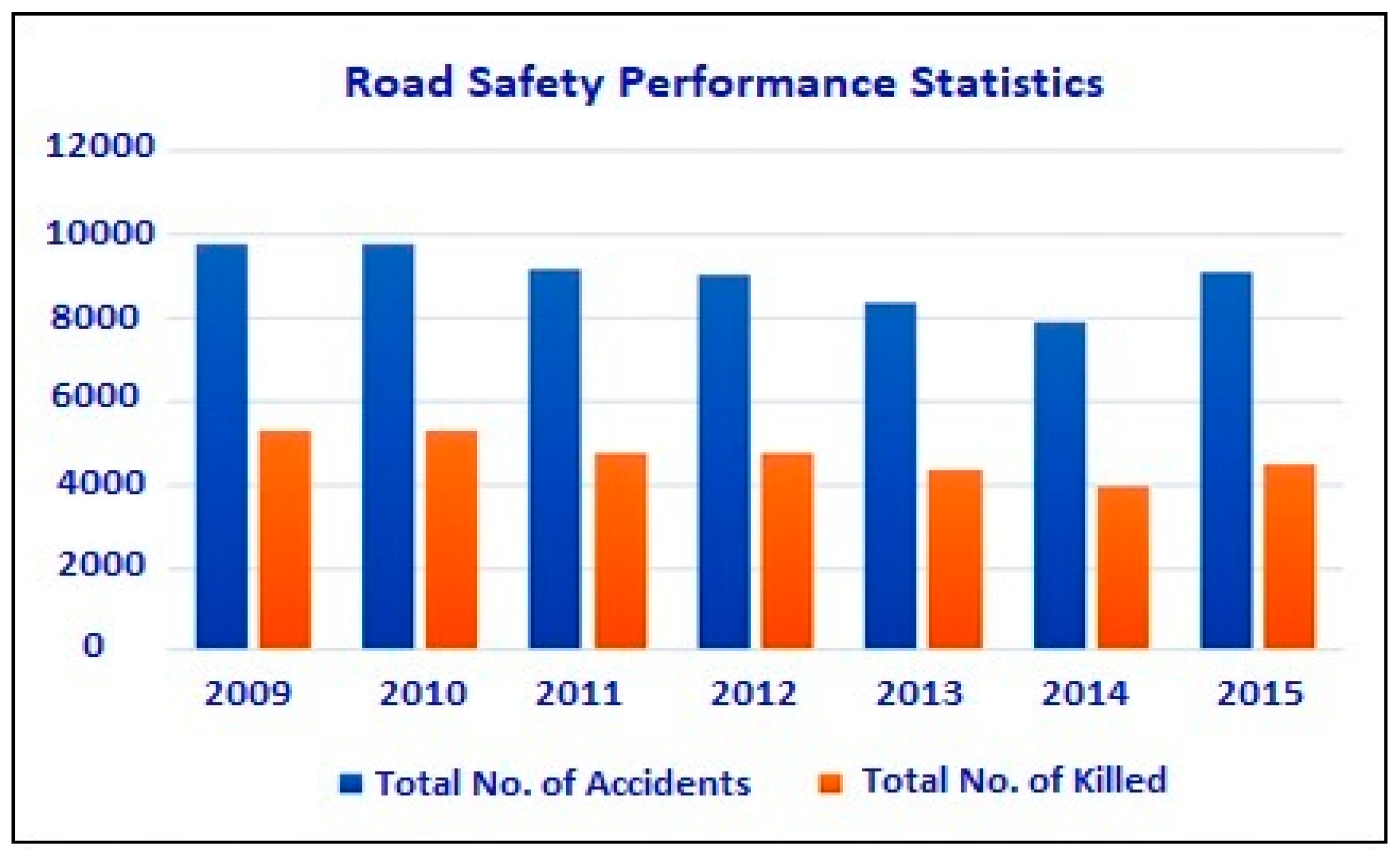
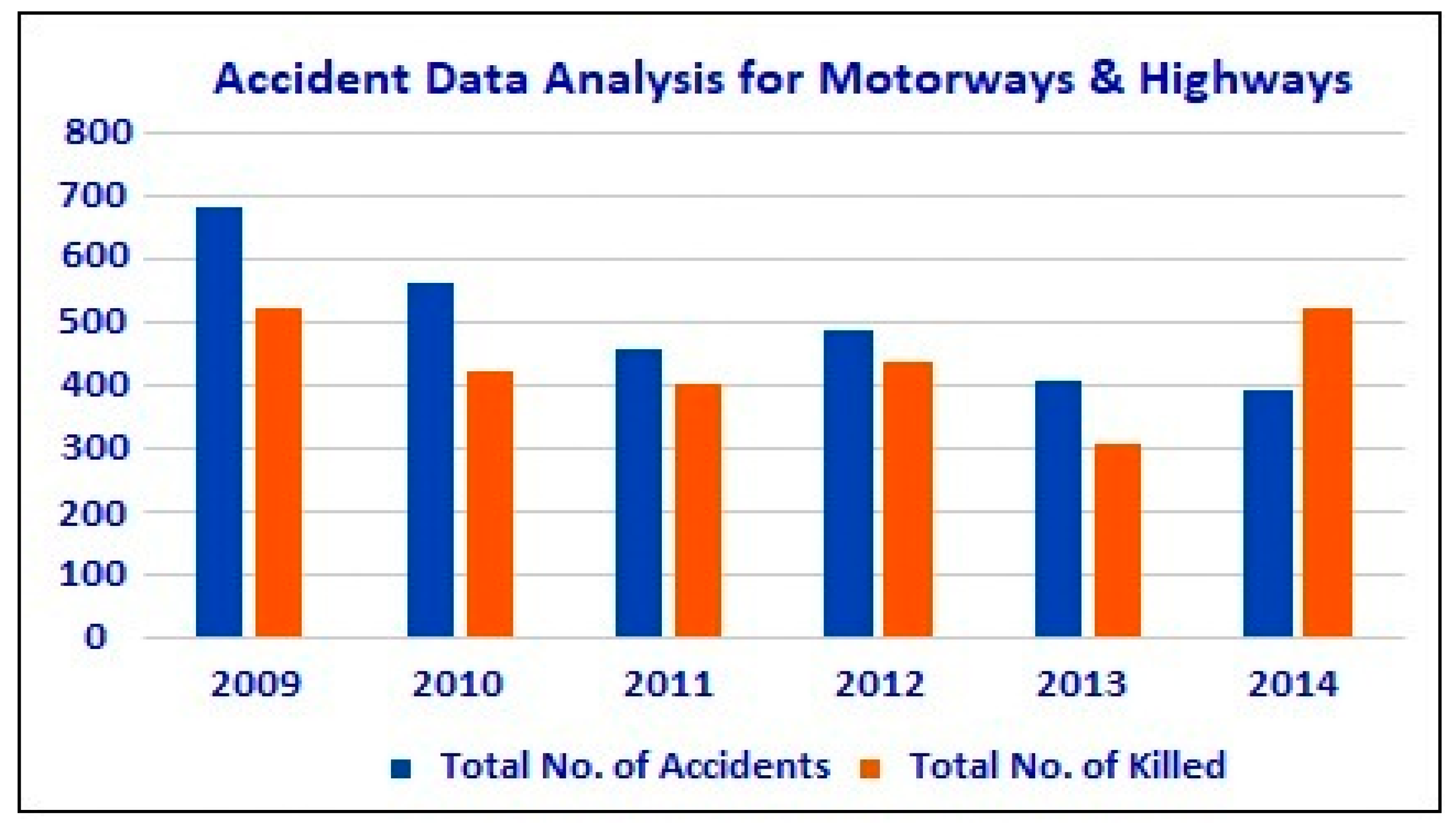
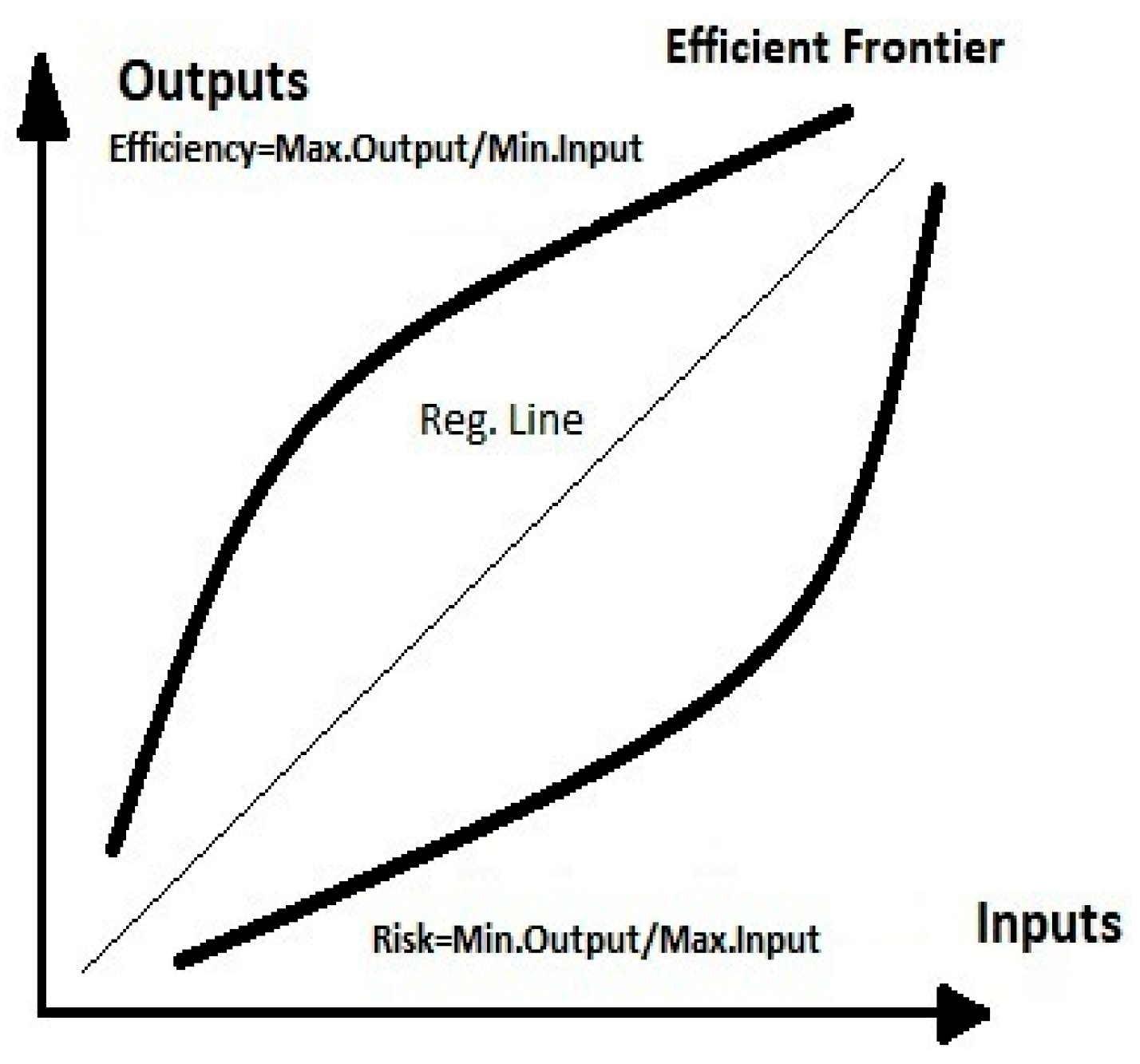
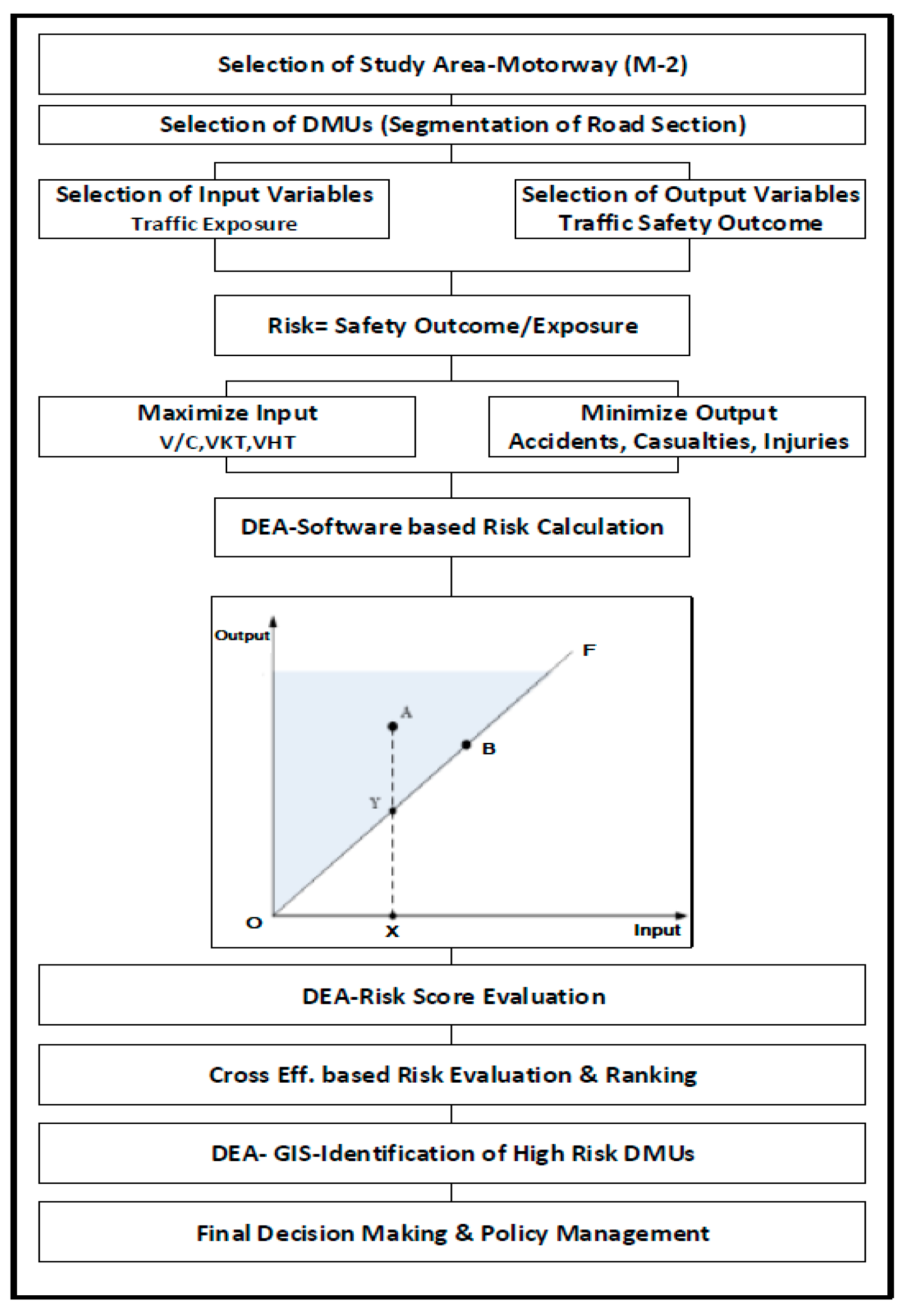
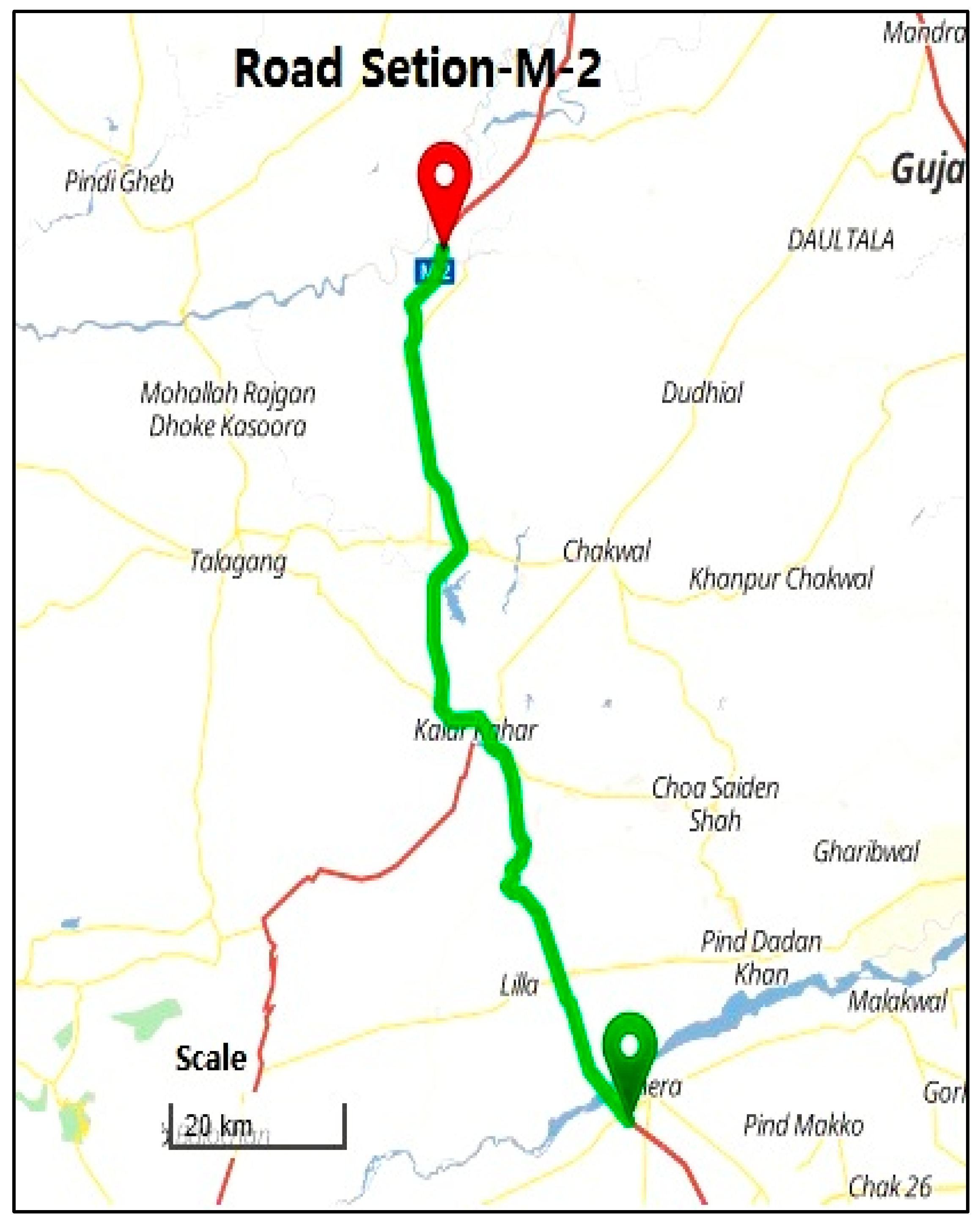
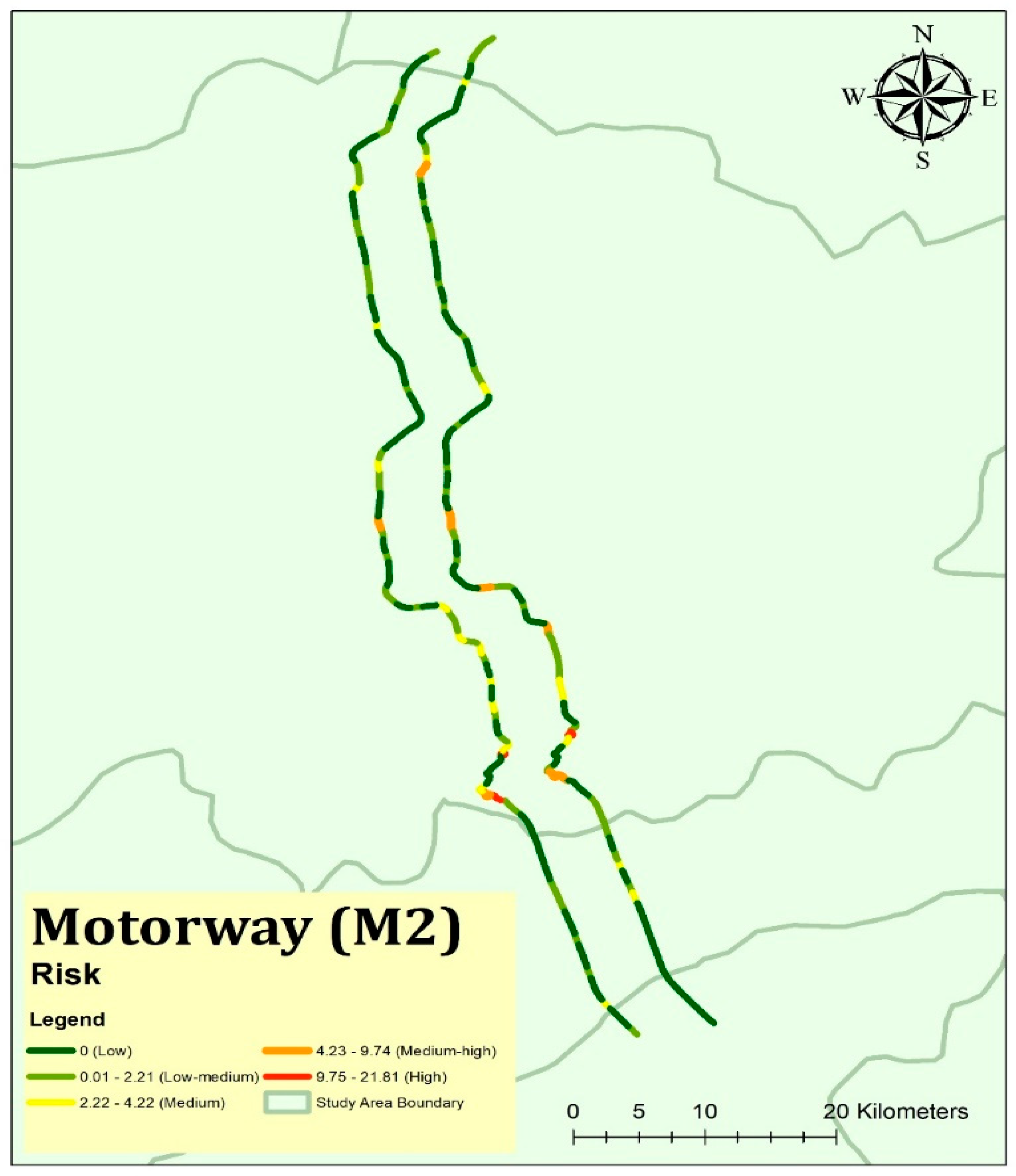
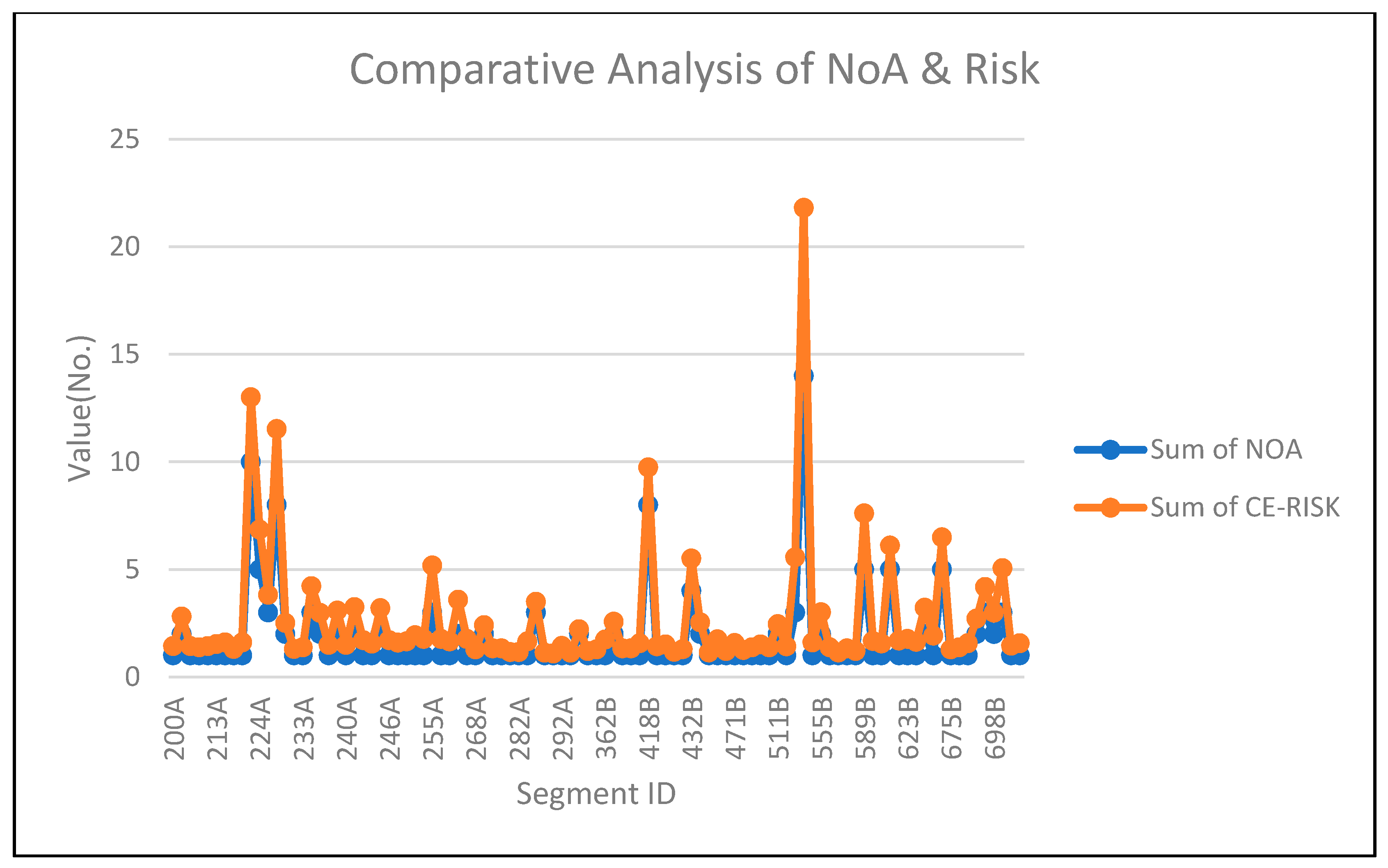
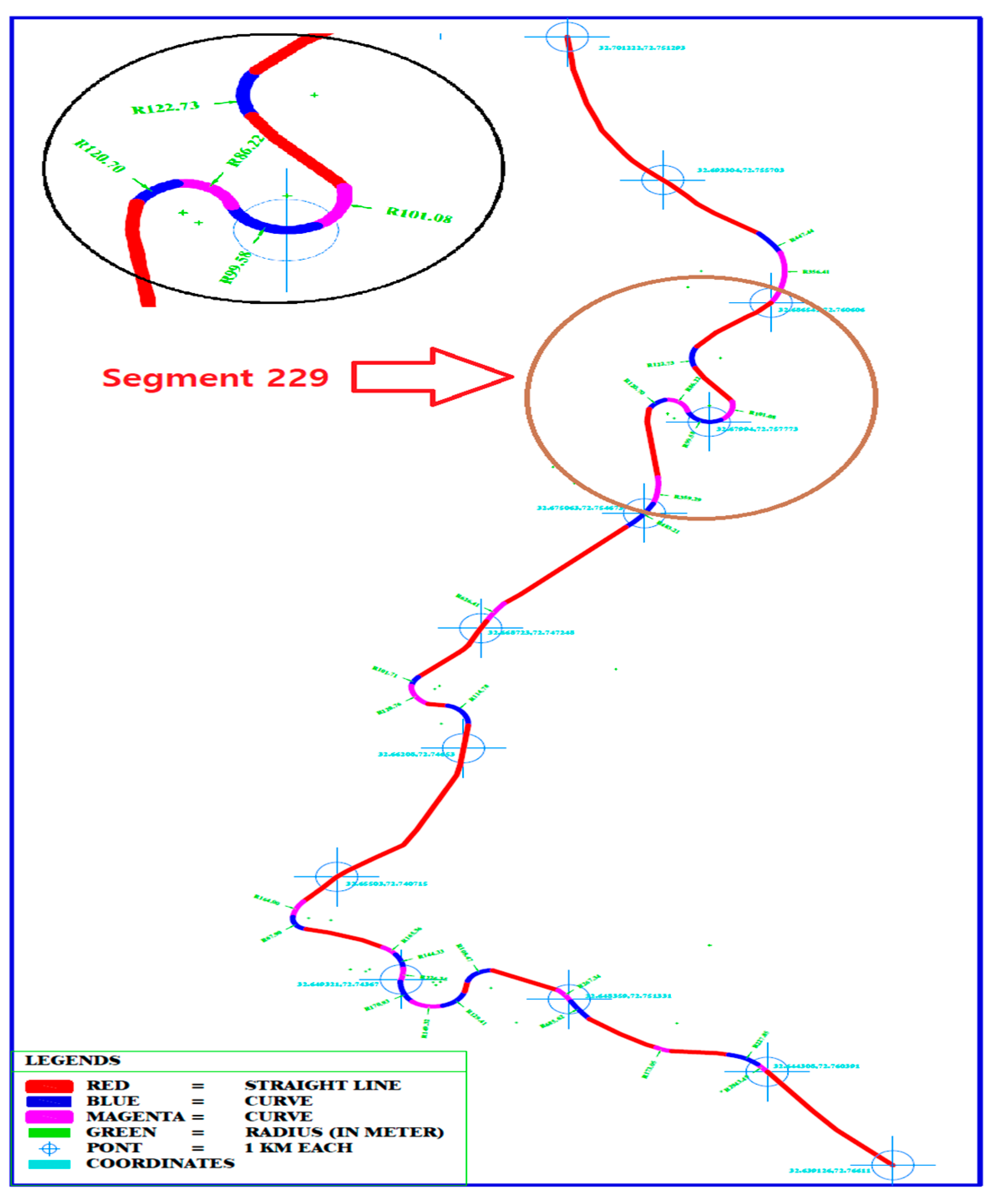
| Stage | Variable | Description | N | Mean | SD | Min. | Q1 | Med. | Q3 | Max. |
|---|---|---|---|---|---|---|---|---|---|---|
| Output | NOA | No. of accidents | 99 | - | - | 1 | 1 | 1 | 2 | 14 |
| NOAP | No. of affected persons: killed or injured | 99 | - | - | 1 | 2 | 4 | 7 | 162 | |
| Input | V/C | Volume/capacity | 99 | 0.050 | 0.006 | 0.042 | 0.045 | 0.047 | 0.056 | 0.060 |
| VKT | Vehicle kilometers traveled | 99 | 8562 | 1077 | 7301 | 7838 | 8092 | 9690 | 10375 | |
| VHT | Vehicle hours traveled | 99 | 7486 | 4324 | 3877 | 4855 | 5509 | 7781 | 19421 | |
| Note: N = number of road segments (Size-1 km each), SD = standard deviation, Q1 and Q3 = quartiles of data | ||||||||||
| DMU | Rated DMU | ||||
|---|---|---|---|---|---|
| 1 | 2 | 3 | …… | n | |
| DMU1 | …… | ||||
| DMU2 | …… | ||||
| DMUn | …… | ||||
| Mean | …… | ||||
| Seg.ID | Km Post | V/C | VKT | VHT | NOA | NOAP | DEA-Risk | RARI (CE-Risk) | Rank |
|---|---|---|---|---|---|---|---|---|---|
| Input I1 | Input I2 | Input I3 | Output O1 | Output O2 | |||||
| 538B | 229 | 0.047 | 8092 | 19,421 | 14 | 162 | 14.00 | 21.81 | 1 |
| 223A | 223 | 0.045 | 7838 | 15,676 | 10 | 30 | 10.91 | 13.00 | 2 |
| 229A | 229 | 0.045 | 7838 | 15,676 | 8 | 50 | 8.72 | 11.53 | 3 |
| 418B | 223 | 0.047 | 8092 | 19,421 | 8 | 24 | 8.00 | 9.74 | 4 |
| 589B | 246 | 0.044 | 7645 | 6116 | 5 | 11 | 6.73 | 7.60 | 5 |
| 224A | 224 | 0.045 | 7838 | 15,676 | 5 | 23 | 5.45 | 6.85 | 6 |
| 670B | 224 | 0.047 | 8092 | 19,421 | 5 | 25 | 5.00 | 6.48 | 7 |
| 609B | 286 | 0.056 | 9690 | 7268 | 5 | 12 | 5.35 | 6.11 | 8 |
| 533B | 253 | 0.044 | 7645 | 4059 | 3 | 18 | 4.08 | 5.56 | 9 |
| 432B | 239 | 0.047 | 8092 | 6474 | 4 | 4 | 5.07 | 5.51 | 10 |
| 255A | 255 | 0.042 | 7301 | 3877 | 3 | 7 | 4.27 | 5.18 | 11 |
| 699B | 254 | 0.044 | 7645 | 4059 | 3 | 9 | 4.08 | 5.06 | 12 |
| 234A | 234 | 0.045 | 7838 | 9406 | 3 | 8 | 3.69 | 4.22 | 13 |
| 694B | 234 | 0.047 | 8092 | 9710 | 3 | 10 | 3.56 | 4.18 | 14 |
| 225A | 224 | 0.045 | 7838 | 15,676 | 3 | 7 | 3.27 | 3.81 | 15 |
| 260A | 260 | 0.042 | 7301 | 3877 | 2 | 7 | 2.85 | 3.59 | 16 |
| 286A | 286 | 0.060 | 10,375 | 7781 | 3 | 9 | 3.00 | 3.50 | 17 |
| 241A | 241 | 0.045 | 7838 | 5879 | 2 | 9 | 2.65 | 3.24 | 18 |
| 661B | 211 | 0.049 | 8400 | 4500 | 2 | 9 | 2.45 | 3.22 | 19 |
| 244A | 244 | 0.042 | 7301 | 5476 | 2 | 4 | 2.84 | 3.20 | 20 |
| - | - | - | - | - | - | - | - | - | - |
| - | - | - | - | - | - | - | - | - | - |
| 453B | 230 | 0.047 | 8092 | 19,421 | 1 | 1 | 1.00 | 1.14 | 95 |
| 560B | 225 | 0.047 | 8092 | 19,421 | 1 | 1 | 1.00 | 1.14 | 96 |
| 293A | 293 | 0.060 | 10,375 | 7781 | 1 | 2 | 1.00 | 1.13 | 97 |
| 287A | 287 | 0.060 | 10,375 | 7781 | 1 | 2 | 1.00 | 1.13 | 98 |
| 288A | 288 | 0.060 | 10,375 | 7781 | 1 | 1 | 1.00 | 1.09 | 99 |
| Advantages | Limitations |
|---|---|
|
|
© 2019 by the authors. Licensee MDPI, Basel, Switzerland. This article is an open access article distributed under the terms and conditions of the Creative Commons Attribution (CC BY) license (http://creativecommons.org/licenses/by/4.0/).
Share and Cite
Shah, S.A.R.; Ahmad, N. Road Infrastructure Analysis with Reference to Traffic Stream Characteristics and Accidents: An Application of Benchmarking Based Safety Analysis and Sustainable Decision-Making. Appl. Sci. 2019, 9, 2320. https://doi.org/10.3390/app9112320
Shah SAR, Ahmad N. Road Infrastructure Analysis with Reference to Traffic Stream Characteristics and Accidents: An Application of Benchmarking Based Safety Analysis and Sustainable Decision-Making. Applied Sciences. 2019; 9(11):2320. https://doi.org/10.3390/app9112320
Chicago/Turabian StyleShah, Syyed Adnan Raheel, and Naveed Ahmad. 2019. "Road Infrastructure Analysis with Reference to Traffic Stream Characteristics and Accidents: An Application of Benchmarking Based Safety Analysis and Sustainable Decision-Making" Applied Sciences 9, no. 11: 2320. https://doi.org/10.3390/app9112320
APA StyleShah, S. A. R., & Ahmad, N. (2019). Road Infrastructure Analysis with Reference to Traffic Stream Characteristics and Accidents: An Application of Benchmarking Based Safety Analysis and Sustainable Decision-Making. Applied Sciences, 9(11), 2320. https://doi.org/10.3390/app9112320




